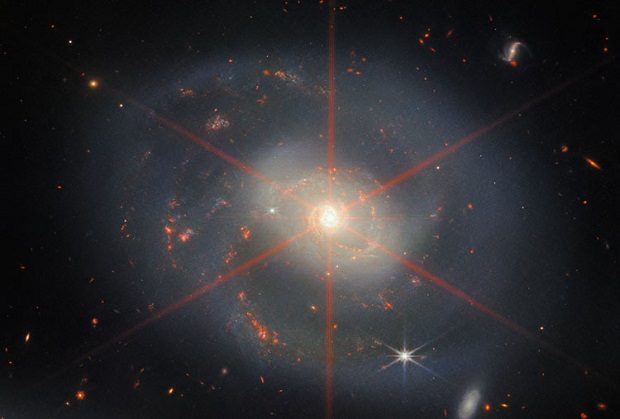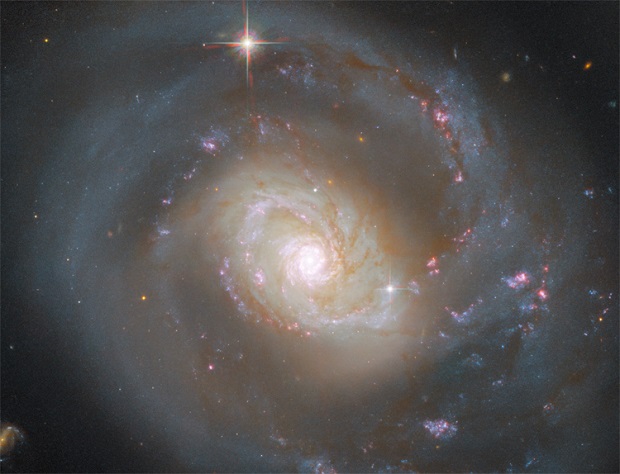
James Webb's New Year photo: Telescope takes beautiful picture of galaxy NGC 7469
In a new image made by the telescope James Webb, you can see the galaxy NGC 7469, turned its entire plane toward Earth. This galaxy is about 220 million light-years from Earth in the constellation Pegasus. It is about 90,000 light-years in diameter and has an active black hole at its center.
A 6-beam star can also be seen in the photo, perfectly aligned with the center of the galaxy and resembling the tip of a Christmas tree. Unlike the galaxy itself, this star is not a real space object, but only an image defect called a defraction burst: this effect was created by the stretching of the telescope's secondary mirror.

You can also see a small part of the galaxy IC 5283 in the lower left part of the image. Together, these galaxies form the Arp 298 structure; they are connected by gravitational interactions and actively influence each other. Observing them allows scientists to better understand the interaction of galaxies at enormous distances, as well as to study the growth of supermassive black holes, using the example of the hole at the center of NGC 7469.
The Hubble telescope also previously took an image of NGC 7469.

As before, the images of the two telescopes differ markedly from each other. The James Webb telescope has infrared observing instruments, which Hubble doesn't have, so the image is brighter in the center, where a lot of matter enters the black hole and a lot of energy is released during the accretion process, including in the infrared spectrum.
Using James Webb's MIRI, NIRCam and NIRspec instruments, the Great Observatories All-sky LIRGs Survey (GOALS) team obtained images and spectra of NGC 7469 with unprecedented detail.
For example, the images show very young star-forming clusters never seen before, as well as pockets of very warm, turbulent molecular gas and direct evidence of the destruction of fine dust within a few hundred light years of the core, proving that an active galactic core (AYAG) can affect the surrounding interstellar environment.
We can also see highly ionized scattered atomic gas that appears to be emerging from the core at about 6.4 million kilometers per hour: this is part of the galactic ejection that has been identified before, but now Webb has shown it in staggering detail.
The James Webb Space Telescope recently took a picture of the famous Pillars of Creation, where new stars form in dense clouds of gas and dust. The Hubble telescope first captured the Pillars of Creation back in 1995. In 2014, the telescope took another picture of the Pillars, a clearer and wider shot in visible light.
Pillars of Creation. Mid-infrared – Near-infrared
- Related News
- The end of the Universe: 3 plausible theories of a global apocalypse
- Mutated bacteria resistant to drugs found on the ISS: What does this mean and why is it a problem?
- 4 flares erupted from Sun in rare event: the Earth may be hit by geomagnetic storm (video)
- 11 incredible satellite photos published on Earth Day
- NASA shows all of Ingenuity's flight trajectories in one video
- Could life exist on Saturn's moon Enceladus?
- Most read
month
week
day
- Once in a lifetime phenomenon: This year we will observe a star explosion that occurred 3,000 years ago 897
- Meta unveils Llama 3 and claims it's the "most powerful" open source language model 895
- WhatsApp to integrate AI function: What will it do? 836
- Google fires 28 employees who protested against company's cooperation with Israel 813
- iPhone 17 Plus will have smaller screen 767
- 5 best smartphones with IPS screens 752
- How DNA analysis helps to solve crimes and who can sell your DNA data and why: Interview with former FBI scientist Bruce Budowle 731
- Huge battery, IP68/IP69K and MIL-STD-810H certifications: Ulefone will present the Armor Pad 3 Pro tablet (photo) 709
- Sentry Enterprise presents first bank card with screen: How does it work? 603
- What risks do crypto and digital currencies pose? Interview with Rasmus Nielsen 578
- Archive
